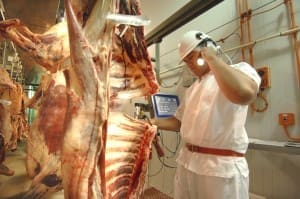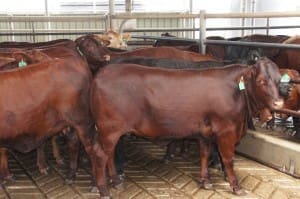REASONABLE flows of slaughter cattle continue to come forward this week, in sharp contrast with earlier predictions made late last year that cattle would be very hard to come-by during the opening stages of the new season, following rain.
 Most processors are reporting satisfactory forward bookings of direct consignment cattle, bolstered by solid yardings through the saleyard system. Today’s Roma store sale, for example is drawing for a large yarding of about 8000 head, while the Warwick sale yesterday carried around 2200 cattle. Gunnedah was solid at 2260 head this week, while combined Toowoomba sales yesterday yarded 2600 head.
Most processors are reporting satisfactory forward bookings of direct consignment cattle, bolstered by solid yardings through the saleyard system. Today’s Roma store sale, for example is drawing for a large yarding of about 8000 head, while the Warwick sale yesterday carried around 2200 cattle. Gunnedah was solid at 2260 head this week, while combined Toowoomba sales yesterday yarded 2600 head.
Price is obviously having a lot to do with that supply response.
While southeast Queensland grids have largely remained unchanged in the past seven days (one exception where a large processor lifted their rate 5-10c to keep in step with a competitor), it is obviously more than adequate to stimulate producers to pull out the drafting cane.
SEQ processor grids seen this morning saw four-tooth grassfed heavy steer 435c-450c, milk and two-tooth steer 445-455c, and best heavy cows for February kill at anywhere from 425-435c. Some processors offer +5c on those rates for no HGP cattle.
Compared with the best prices seen late last year, cow rates are now up to 65c higher, dressed weight; and four-tooth heavy grassfed ox 50c higher. PCAS-eligible steer is now quoted at an unheard-of 510c/kg, with Certified Organic grassfed steer this week a stratospheric 570c/kg.
Beef Central has heard of fair-sized grassfed steer consignments this week where vendors have banked $1500 to $1600 per beast, even after grid penalties. That’s big, big money in anybody’s language.
The continued fall in the value of the A$ is absolutely helping fuel that appetite among processors to push grids higher. The A$ this morning was quoted at US78.01c, after dropping well into the 77s yesterday, another six-year low.
The Eastern States weekly kill reported by NLRS took a predictable step back last week, as most plants dropped their Monday kills for the Australia Day public holiday.
The five-state kill sank more than 21,000 head last week as a result of the short week, or close to 14 percent.
Queensland’s numbers were back 14pc to 63,919 head, while NSW was -16pc at 34,220 head. Victoria recorded a kill of 28,720 head (-11pc); South Australia 9956 head (+5pc), and Tasmania 4051 head (-18pc).
Contrast in female portion
 There are some interesting contrasts being seen in the percentage of females in the overall slaughter numbers in the two states that record gender – Queensland and NSW.
There are some interesting contrasts being seen in the percentage of females in the overall slaughter numbers in the two states that record gender – Queensland and NSW.
Queensland’s female portion last week accounted for just 40.6pc, which is a dramatic contrast to the +50pc figures seen during last year’s drought, as producers liquidated females. Adding to that is the high rate of grainfed kill in Queensland at present, a reflection of the heavy reliance on feedlots during the latter half of last year due to drought. That tends to skew the gender bias, in export-weight cattle at least, towards steers.
The trend could not be more different in NSW. Last week’s kill saw females accounting for more than 52pc of the state’s total kill – still close to last year’s historic highs.
That seems unusual, given the turnaround in the seasonal fortunes in many areas. But the most plausible explanation appears to be twofold:
- The higher focus on domestic markets in NSW, where heifers make up a larger percentage of grainfed yearlings for slaughter. Added to that, 60-70 day grainfed heifers being killed this week are still a ‘result’ of feedlot placements made back late last year, before many people had had rain. It suggests grainfed heifer numbers in NSW may subside, as the effects of more recent weather starts to be seen in the supply chain.
- The other factor is the high cull cow turnoff typically at this time of year in NSW, and the fact that prices for cows remain at record levels (reference quotes above).



HAVE YOUR SAY